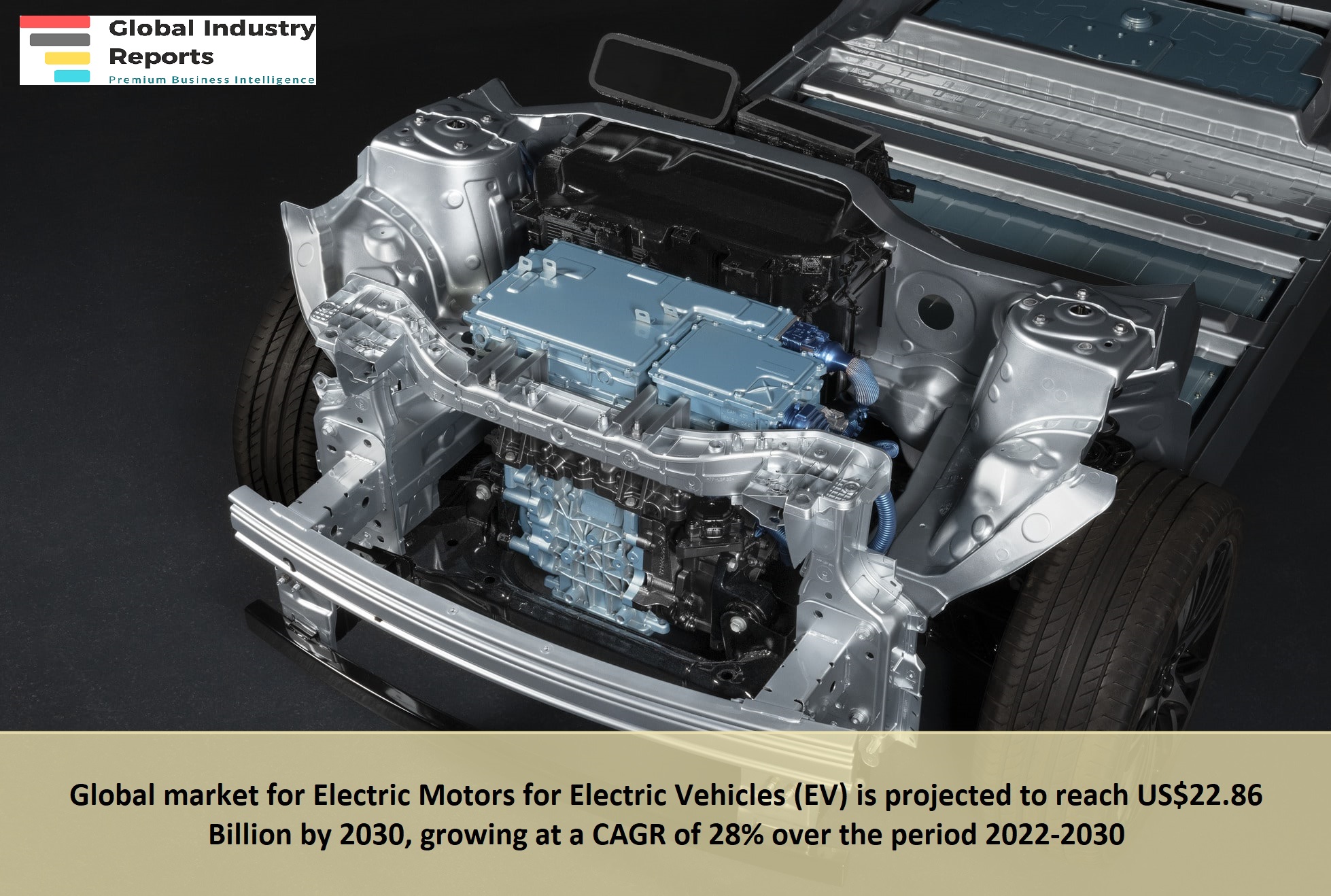Report Overview
- Understand the latest market trends and future growth opportunities for the Electric Motors for Electric Vehicles industry globally with research from the Global Industry Reports team of in-country analysts – experts by industry and geographic specialization.
- Key trends are clearly and succinctly summarized alongside the most current research data available. Understand and assess competitive threats and plan corporate strategy with our qualitative analysis, insight, and confident growth projections.
- The report will cover the overall analysis and insights in relation to the size and growth rate of the “Electric Motors for Electric Vehicles Market” by various segments at a global and regional level for the 2010-2030 period, with 2010-2021 as historical data, 2022 as a base year, 2023 as an estimated year and 2023-2030 as forecast period.
Description:
- Electric motors play a crucial role in driving electric vehicles (EVs), alongside batteries and power electronics. While the development of electric traction motors dates back to the 1800s, the market continues to evolve, incorporating new designs, enhanced power and torque density, and advancements in material selection. These advancements go beyond mere incremental improvements, as innovative developments like axial flux motors and the elimination of rare-earth elements by various original equipment manufacturers (OEMs) are reshaping the landscape.
- The GIR Research report titled “Electric Vehicle Motors 2024-2034” delves into OEM strategies, emerging trends, and evolving technologies within the EV motor market. Leveraging an extensive model database comprising over 500 EV variants sold between 2015 and 2022 across multiple geographical regions, the report enables a detailed market analysis covering motor types, performance, thermal management, and market shares. The report examines the technologies and strategies adopted by major OEMs across various vehicle categories, including cars, two-wheelers, three-wheelers, microcars, light commercial vehicles (vans), trucks, and buses. It also encompasses multiple use-cases and benchmarking of different motor units. Furthermore, the report provides market forecasts up to 2034, encompassing emerging technologies such as axial flux motors and in-wheel motors.
- The global market for Electric Vehicles (EVs) estimated at 9.5 Million Units in the year 2022, is projected to reach a revised size of 80.7 Million Units by 2030, growing at a CAGR of 30.7% over the period 2022-2030. Battery Electric Vehicles (BEVs), one of the segments analyzed in the report, is projected to record 34.8% CAGR and reach 74.4 Million Units by the end of the analysis period. Taking into account the ongoing post pandemic recovery, growth in the Plugin Hybrid Electric Vehicles (phevs) segment is readjusted to a revised 11.6% CAGR for the next 8-year period.

MARKET DATA INCLUDED
- Unit Sales, Average Selling Prices, Market Size & Growth Trends
- COVID-19 Impact and Global Recession Analysis
- Analysis of US inflation reduction act 2022
- Global competitiveness and key competitor percentage market shares
- Market presence across multiple geographies – Strong/Active/Niche/Trivial
- Online interactive peer-to-peer collaborative bespoke updates
- Market Drivers & Limiters
- Market Forecasts Until 2030, and Historical Data to 2015
- Recent Mergers & Acquisitions
- Company Profiles and Product Portfolios
- Leading Competitors
Electric Motors for Electric Vehicles Report Includes:
- Analysis of the electric motor markets in BEVs, PHEVs and HEVs across cars, two-wheelers, three-wheelers, microcars, light commercial vehicles (vans), trucks, and buses including:
- Benchmarking different motor types/topologies
- OEM strategies
- EV industry trends and the impact on electric motors
- Trends in motor design
- Emerging motor technologies and benchmarking: axial flux, in-wheel and switched reluctance
- Materials utilization: magnets (including rare earths) and windings (round or hairpin)
- Thermal management of electric motors
- EV use-cases and benchmarking
- Company profiles including interviews.
10 Year Market Forecasts & Analysis:
- Automotive electric motor forecast 2015-2034 (regional): China, Europe, US and rest of world (units, kW)
- Automotive electric motor forecast 2015-2034 (drivetrain): BEV, PHEV and HEV (units, kW)
- Automotive electric motor forecast 2015-2034 (motor type): alternating current induction motor (ACIM), permanent magnet (PM), wound rotor synchronous motor (WRSM), permanent magnet rare earth free, other rare earth free, axial flux (units)
- Automotive electric motor value forecast (drivetrain): BEV, PHEV and HEV (US$)
- Micro-EV motor forecast: two-wheelers (<4 kW and >4 kW), three-wheelers (<4 kW and >4 kW), microcars (units, kW, and US$)
- Electric light commercial vehicle (van) motor forecast: BEV & PHEV (units, kW, and US$)
- Electric truck motor forecast: medium- and heavy-duty BEV, PHEV and HEV (units, kW, and US$)
- Electric bus motor forecast: BEV, PHEV & HEV (units, kW, and US$)
- Automotive HEV motor forecast: China, Europe, US, Japan, South Korea and rest of world (units, kW)
- Automotive axial flux motor forecast (units)
- In-wheel motors forecast (units)
- Materials for motor magnets forecast split into elements (tonnes)
- Forecast for aluminum, copper, and steel (tonnes)
Electric Motors for Electric Vehicles Reports Scope and Segments:
| Report Attribute | Details |
| Market size in 2022 | US$5.2 Billion |
| Market size forecast in 2030 | US$22.86 Billion |
| Growth Rate | CAGR of 28% from 2022 to 2030 |
| Base year for estimation | 2022 |
| Historical data | 2015 – 2022 |
| Forecast period | 2023 – 2030 |
| Quantitative units | Revenue in USD million and CAGR from 2023 to 2030 |
| Report coverage | Revenue forecast, company ranking, competitive landscape, growth factors, trends, DROT Analysis, Market Dynamics and Challenges, and Strategic Growth Initiatives
COVID-19 Impact, Market Growth Trends, Market Limiters, Competitive Analysis & SWOT for Top Competitors, Mergers & Acquisitions, Company Profiles, Product Portfolios Market Size, Market Shares, Market Forecasts, Market Growth Rates, Units Sold, and Average Selling Prices. |
| Segments covered | Technology, Type, Product, Power, Application and Region |
| Regional scope | North America; Europe; Asia Pacific; Latin America; Middle East and Africa and rest of the world |
| Country scope | United States, Russia, China, Germany, United Kingdom, France, Japan, Israel, Saudi Arabia, South Korea, United Arab Emirates, Canada, Switzerland, Australia, India, Italy, Turkey, Qatar, Sweden, Spain, Belgium, Netherlands, Norway, Singapore, Egypt, Denmark, Austria, Vietnam, Brazil, Argentina, Mexico, South Africa, and others. |
| Key companies profiled | ABB Ltd.; Audi AG; Bentley; Beyond Motors; BMW Group; BorgWarner Inc.; Bosch Mobility Solutions; Brose Fahrzeugteile GmbH & Co. KG; BYD Auto; Continental AG; Daimler AG (Mercedes-Benz); Dana Incorporated; Danfoss Editron; Denso Corporation; Detroit eAxles; Elaphe; Elemental Motors; EMRAX; Enedym; ePropelled; Evolito; FCA; Ferrari; Ford Motor Company; FPT Truck Motors; Geely Auto Group; Gem Motors; General Motors; H3X; Hitachi Automotive Systems, Ltd.; Honda Motor Co., Ltd.; Hyundai Mobis Co., Ltd.; Infinitum Electric; Jing-Jin Electric Technologies (Beijing) Co., Ltd.; Johnson Electric Group; Koenigsegg; Lamborghini; LG Electronics; Lordstown Motors (Elaphe); Lucid Air; Magelec Propulsion; MAGicALL; Magna International Inc.; Mahle GmbH; Meritor; MG Motors; MGM COMPRO; Mitsubishi Electric Corporation; Nidec Corporation; Nissan; Panasonic Corporation; Porsche; Protean Electric; REE Automotive; Renault Group; RETORQ Motors; Rivian; Rolls-Royce; SAFRAN; SAIC Motor Corporation Limited; Saietta; Schaeffler AG; Shriram Pistons Ltd.; Siemens AG; SPR Engineous; Stellantis; Tesla; Toshiba Corporation; Toyota Motor Corporation; Traktionssysteme Austria (TSA); Turntide; Valeo SA; Vitesco; Volkswagen Group; Volvo; WEG S.A.; Yamaha; YASA and Koenigsegg; ZF Friedrichshafen AG and others |
| Customization scope | Free report customization (equivalent up to 20 analyst’s working days) with purchase. Addition or alteration to country, regional & segment scope. |
| Report Format | PDF, PPT, Excel & Online User Account |
Electric Motors for Electric Vehicles Report Segmented by:
By Assembly:
- Wheel Hub
- Central Power Train
By Application:
- Passenger Cars
- Commercial Vehicles
By Motor Type:
- Brushless DC Motor
- Permanent Magnet Synchronous Motor
- Asynchronous Motor
- Synchronous Reluctance Motor
- Others (Axial Flux Ironless Permanent Magnet Motor, Switched Reluctance Motors, etc.)
By Power:
- Up to 100 kW
- 101-250 kW
- Above 250 kW
By Region:
- North America
- Europe
- Asia Pacific
- Latin America
- Middle East & Africa
- Rest Of The World
Top Companies Covered in Electric Motors for Electric Vehicles Report:
| ABB Ltd. | Magelec Propulsion |
| Audi AG | MAGicALL |
| Bentley | Magna International Inc. |
| Beyond Motors | Mahle GmbH |
| BMW Group | Meritor |
| BorgWarner Inc. | MG Motors |
| Bosch Mobility Solutions | MGM COMPRO |
| Brose Fahrzeugteile GmbH & Co. KG | Mitsubishi Electric Corporation |
| BYD Auto | Nidec Corporation |
| Continental AG | Nissan |
| Daimler AG (Mercedes-Benz) | Panasonic Corporation |
| Dana Incorporated | Porsche |
| Danfoss Editron | Protean Electric |
| Denso Corporation | REE Automotive |
| Detroit eAxles | Renault Group |
| Elaphe | RETORQ Motors |
| Elemental Motors | Rivian |
| EMRAX | Rolls-Royce |
| Enedym | SAFRAN |
| ePropelled | SAIC Motor Corporation Limited |
| Evolito | Saietta |
| FCA | Schaeffler AG |
| Ferrari | Shriram Pistons Ltd. |
| Ford Motor Company | Siemens AG |
| FPT Truck Motors | SPR Engineous |
| Geely Auto Group | Stellantis |
| Gem Motors | Tesla |
| General Motors | Toshiba Corporation |
| H3X | Toyota Motor Corporation |
| Hitachi Automotive Systems, Ltd. | Traktionssysteme Austria (TSA) |
| Honda Motor Co., Ltd. | Turntide |
| Hyundai Mobis Co., Ltd. | Valeo SA |
| Infinitum Electric | Vitesco |
| Jing-Jin Electric Technologies (Beijing) Co., Ltd. | Volkswagen Group |
| Johnson Electric Group | Volvo |
| Koenigsegg | WEG S.A. |
| Lamborghini | Yamaha |
| LG Electronics | YASA and Koenigsegg |
| Lordstown Motors (Elaphe) | ZF Friedrichshafen AG |
| Lucid Air | Others |
After Sales Support
- Every updated edition of the report and full data stack will be provided at no extra cost for 24 months.
- Latest 2022 base year report.
- Free Updated edition of 2023 every quarter without any hidden cost.
- No user limitation for the report. Unlimited access within the organization.
- Unrestricted post-sales support at no additional cost
- Free report customization (equivalent up to 10 analyst’s working days) with purchase. Addition or alteration to country, regional & segment scope
- Global Industry Reports will support your post-purchase for a period of 24 months to answer any of your queries related to the following market and to provide you any more data needed, for your analysis.
- Option to purchase regional or selected Chapters from the report.
Key Questions Answered in this Report
- How will the electric motors for electric vehicles market evolve?
- Who are the key players in electric motors for electric vehicles market? What are their strategies?
- What is the competitive landscape?
- What are the needs, challenges, and solutions in electric motors for electric vehicles market?
- What’s the value chain for electric motors for electric vehicles?
- What’s the forecast for electric motors for electric vehicles market adoption in the next decade?
- What are the drivers for adoption of electric motors for electric vehicles?
- What’s the right price? The right timing?
- Will this market happen at all? How big can it get?









